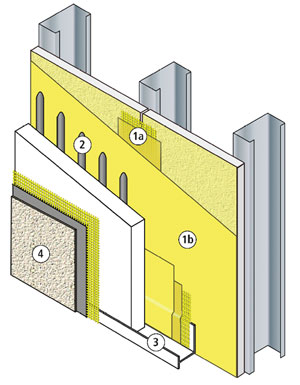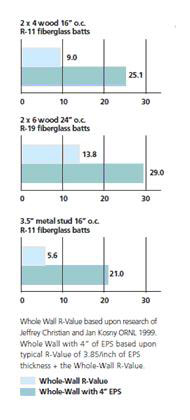EIFS Update: Pick the Right Substrate
Exterior Insulation and Finish Systems Characteristics
 |
Figure 1: The typical components in a total wall construction using an Exterior Insulation and Finish System (EIFS) Image courtesy of STO Corp. |
According to the EIFS Industry Members Association (EIMA), EIFS were initially developed in Europe in the 1950s then introduced in the U.S. almost40 years ago. "They were first used on commercial buildings, and later, on homes. Today, EIFS account for nearly 30 percent of the U.S. commercial exterior wall market." EIMA and others point out that a total wall system using EIFS typically consists of the following components (See Figure 1).
- Wall framing on steel studs is designed and installed in standard fashion either as the structural component of the wall or as infill between the primary structural frame. Depending on a given situation, insulation may or may not be installed between the wall studs. Further, since the EIFS is lighter in weight than masonry, stone, or concrete cladding, the impact on the structure is less, often resulting in some cost savings on the structural frame.
- A solid substrate panel attached to the outside of the studs. This is the layer that is typically installed by someone other than the EIFS subcontractor, but has a big impact on the performance of the system and the flow of construction activity. Not surprisingly, manufacturers and technical specialists have developed particular and stringent requirements for this substrate layer. Further, the joints of this layer need to be covered with an appropriate mesh or wide tape-like seal.
- A water-resistant barrier or liquid membrane applied over the substrate before the installation of insulation. This barrier has been added in recent years in response to some past concerns about water penetration into the rest of the wall assembly and has been shown to be an effective solution to those concerns.
- Insulation board adhesive typically consisting of a specially formulated make-up to adhere to the membrane-coated substrate as well as the insulation. The prevailing installation method is to install the adhesive in continuous vertical ribbons that allow any trapped moisture to drain down the surface of the coated substrate and weep out the bottom. While less common, the insulation can also be held in place with mechanical fasteners, although each fastener will obviously compromise the integrity of the water-resistant barrier.
- Rigid insulation boards that are commonly made of expanded polystyrene (EPS) or polyisocyanurate foam and can range in thickness from 1 to 4 inches. The preference is for a single board of the desired thickness rather than multiple, overlapping layers requiring additional labor and potential for separation. The insulation is usually set into a base channel or starter track mounted at the bottom of the exterior wall. This track is intended to contain regularly spaced weep holes to allow the release of any trapped moisture but not compromise the thermal integrity of the wall.
- A formulated base coat that is durable and water-resistant is then hand applied on top of the insulation. Fiberglass mesh is commonly installed as part of this base coat as reinforcement for added tensile strength.
- A finish coat selected for attractiveness and durability. Typically this finish coat is made with an acrylic material that employs co-polymer technology, all of which is known to be both colorfast and crack-resistant. In some cases, an intermediate coat may also be applied between the base and finish coats.
 |
Figure 2: Comparison of composite or whole wall R-values in different types of walls using fiberglass insulation between wall studs versus 4" exterior insulation. Image and data courtesy of STO Corp. and the Oak Ridge National Laboratory |
Variations do occur in this make-up between different manufacturers and for different applications, but the fundamental process is the same and produces the same basic characteristics of the wall. According to the National Institute of Building Sciences (NIBS)Whole Building Design Guide, those characteristics include the following four quoted in part below:
- First, placing all of the insulation outside of the wall cavity reliably locates the dew point (the temperature at which humidity condenses to form water) outside of the wall cavity. This is a key consideration. Dew formation inside the wall can create conditions conducive to mold growth and material decomposition. Cavity insulation moves the dew point inward, and should be balanced with an appropriate amount of exterior insulation. By exploiting the high insulation value of insulation board used in an EIFS, walls can be designed to locate the dew point outside the wall sheathing. In an EIFS with drainage, sheathing is protected with a secondary water-resistive barrier and a drainage plane. Design professionals should always evaluate dew point locations for their projects.
- Second, exterior insulation eliminates thermal bridging (heat transfer across a solid element such as wall framing). This is a very important consideration that has gained increased attention in recent years. In many climate zones, steel framed walls cannot meet prescriptive requirements without continuous exterior insulation. This is because thermal bridging reduces the effectiveness of cavity insulation by up to 65 percent. (See Figure 2.)
By way of example, R-21 batt insulation in certain cases delivers as little as R-7.4 actual measured performance. The reason for this decrease in performance is the regular interruption of the insulation by the wall framing at 16 or 24 inches on center plus top and bottom tracks/plates and framing around openings. The combined area of all of that framing can account for up to a third of a wall surface with a substantially lower or even negligible R-value. Worse yet, steel studs efficiently conduct heat across their depth accelerating the unwanted heat flow. Using exterior insulation eliminates this problem since all of the framing is contained inside the thermal envelope of the building and does not have an opportunity to create a thermal bridge to the exterior. Hence, the building is capable of performing to its full energy efficiency potential.
- Third, rigid insulation board can be highly cost-effective. Increasing the thickness of the insulation board adds insulation value for material cost only, since little or no extra labor is needed. In addition, all costs associated with cavity insulation can often be eliminated.
- Fourth, thermal expansion and contraction of the building framing is dramatically reduced because framing is no longer subject to daily temperature changes. This reduces building movement and associated stresses.
NIBS goes on to point out that the only drawback they find to a completely exterior insulation system is a slight increase in overall wall thickness which presumably can be addressed by appropriate design measures.









